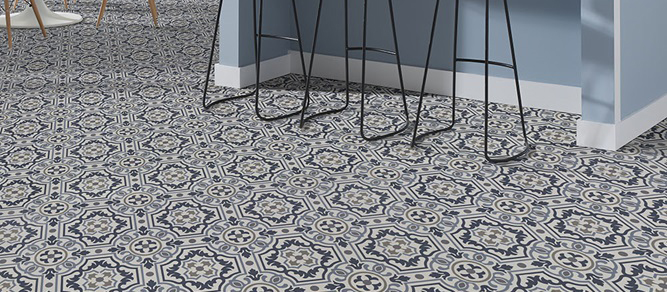Vinyl sheet is often used as an alternative to natural stone, ceramic tile or even hardwood, especially in rooms like kitchens, laundry rooms and bathrooms that are more susceptible to moisture. The layered construction provides stability, cushioning and a protective finish for durability.It comes in a 12-foot-wide roll, which the flooring company will cut to size. Depending on the size of your room, you may just need a single roll, but regardless, this type of flooring leaves few (if any) seams.
Benefits of Vinyl Flooring
Water Resistant - Made with waterproof materials, such as PVC, makes this flooring option perfect for water prone areas of the home.
Stain Resistant - Printed vinyl tiles and sheets have a clear wear layer that acts as a surface barrier, protecting the floor from stains and spills.
Comfort - Softer and warmer underfoot than other hard-surface flooring options, making it much easier to stand on for long periods of time.
Durability - Vinyl sheet flooring is a highly durable material that, if properly installed and maintained, can last upwards of ten to twenty years.
Affordable - Costs less than tile or plank vinyl with similar colors and patterns.
Low Maintenance - Clean it by sweeping off dirt and grit and by mopping it afterwards.
Ease of Installation - With the right preparation and adhesive, learning how to install vinyl flooring can be installed over almost any clean, dry surface
Design Options - The newest collections have improved color, clarity, textures and patterns all thanks to innovative technology. It’s what gives the flooring the realistic look and feel of hardwood, stone and even ceramic tile, but without the high cost.
How Sheet Vinyl is Constructed

Sheet vinyl is composed of 6 layers
Top coat - Adds sheen as it protects the wear layer
Wear layer - Safeguards the pattern layer
Pattern layer - Supplies the sheet's color and look
Cushion layer - Adds bounce and texture
Fiber glass - Keeps the sheet flat
Base layer - Supports all the layers
How to Clean and Maintain Sheet Vinyl

Place floor mats at the entry points of the home to catch loose dirt
Vacuum regularly and mop with soapy water to remove grime and keep colors bright.
Do not use abrasives, bleach, or ammonia.
Wipe up spills to prevent stains.













Comments